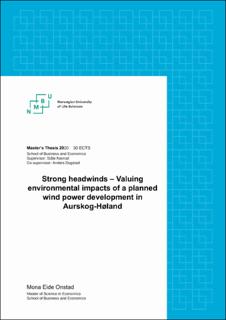| dc.contributor.advisor | Navrud, Ståle | |
| dc.contributor.advisor | Dugstad, Anders | |
| dc.contributor.author | Onstad, Mona Eide | |
| dc.coverage.spatial | Norway, Akershus, Aurskog-Høland | en_US |
| dc.date.accessioned | 2021-02-03T12:53:33Z | |
| dc.date.available | 2021-02-03T12:53:33Z | |
| dc.date.issued | 2020 | |
| dc.identifier.uri | https://hdl.handle.net/11250/2726001 | |
| dc.description.abstract | The main aim of this thesis is twofold: i) add to the scarce empirical evidence of the environmental costs of local wind power developments in Norway, and ii) add to the methodological development of stated preference methods in this context by comparing estimates from Contingent Valuation (CV) and Choice Experiments (CE) over two elicitation formats (Willingness to pay (WTP) to avoid the wind farm and Willingness to accept (WTA) compensation to have the wind farm). After careful pilot testing, data for 393 respondents in the Aurskog-Høland Municipality were obtained in an internet survey with recruitment both from an internet panel and by phone. The subsample that was asked for WTA in both CE and CV worked well, while we quite early in the sampling period had to stop the WTP subsample due to heavy local protests to this elicitation format. This resulted in only 85 observation for the WTP subsample and the remaining 308 in the WTA subsample instead of the planned 50-50 split. In CE, the attribute of overhead powerlines needed for the wind power development was found to cause the largest welfare loss to the locals. In CV a disparity was observed between mean WTA of NOK 8600 (NOK 7822 – 9378), and mean WTP of NOK 1578 (NOK 1457 – 1699) per household per year. Thus, welfare loss due to the wind power development was more than 5 time higher in the WTA subsample. After the first interval regression models, the dependent variable was altered in order to analyze the two separate consideration a respondents makes when answering the CV question: i) whether to pay or demand compensation, ii) if they decide to pay or demand in compensation, how much should it be. This was an important distinction to make, because some variables changed coefficients in the separate analysis. The income variable, for example, had opposite signs of the coefficients in the WTA sample for the logit model and the interval regression with only positive values. A respondent with lower income was more likely to demand compensation, yet a respondent with higher income demanded more. Thus, the way a policymaker maker asks about compensation is important for the outcome. The results of this thesis can be used in Cost-Benefit analysis to decide whether to pursue a wind power development or not. This is done by aggregating all environmental costs of the wind farm (from CE or CV) over the number of affected households, which can be added to investment and operating costs of the windfarm and compared to the social benefits of electricity production. | en_US |
| dc.language.iso | eng | en_US |
| dc.publisher | Norwegian University of Life Sciences, Ås | en_US |
| dc.rights | Attribution-NonCommercial-NoDerivatives 4.0 Internasjonal | * |
| dc.rights.uri | http://creativecommons.org/licenses/by-nc-nd/4.0/deed.no | * |
| dc.title | Strong headvinds : valuing environmental impacts of a planned wind power development in Aurskog-Høland | en_US |
| dc.title.alternative | Sterk motvind : verdsetting av miljøeffekter av et planlagt vindkraftverk i Aurskog-Høland | en_US |
| dc.type | Master thesis | en_US |
| dc.description.localcode | M-ECON | en_US |

